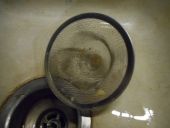My impression is that humus is composed of mix polysaccharides and glycoproteins. It is not true that all the "organic matter" is gone if what you mean is carbon (that's what "organic" means to a chemist). Lignin, for instance is made up of very mixed, very complex polysaccharides. Lignin doesn't have a single chemical formula. It is more like something generated by a regular expression, like language. A molecule could be branches and each branch consisting of a stretch of amino acids, a stretch of linked sugar, modified amino acids, alcohols. There is carbon in the amino aids and sugar, but it is very hard to break down. When I was in biochemistry I couldn't figure out how the amount of cellulose was quantitated in a sample mentioned in a scientific article. I traced back through back reference after back reference and finally established that cellulose was measured as what is left after you degrade everything else. These days there are enzymes (cellulases) that can degrade cellulose but if humus is a mixed molecule then a
cellulase won't be able to degrade much of humus.





